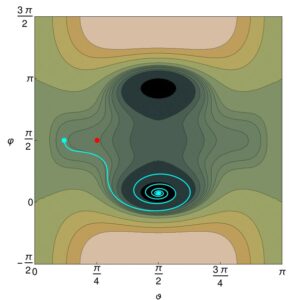Spontaneous symmetry breaking is a physical phenomenon when some system decides to choose one of several options in an unpredictable way.
For example, an egg placed on its tip will roll to the side. If it was placed on the tip precisely, it is not possible to predict in advance which side it will roll to. Although this problem may seem impractical, it is quite common in practice. The beams of an overloaded bridge structure are subject to spontaneous symmetry breaking for example. The overloaded beam bulges to the side after the critical load is applied. The next example of spontaneous symmetry breaking is the crystallization of a substance without a pre-prepared crystallization center. The preferred orientation of the growing crystal is random. In our paper, we show that spontaneous symmetry breaking occurs less often in magnetic systems than might be expected. The reason is the dynamics of magnetization is closely connected with the precessional movement of magnetic dipoles. As we show in our article, precessional motion can in some cases cause the emergence of a new symmetry in the magnetic system. This effect is stronger the faster the system is forced to change its magnetic state.
This effect can be eventually used for fast switching of magnetic nano-devices in the future.
Link: https://doi.org/10.1002/pssr.202200459







